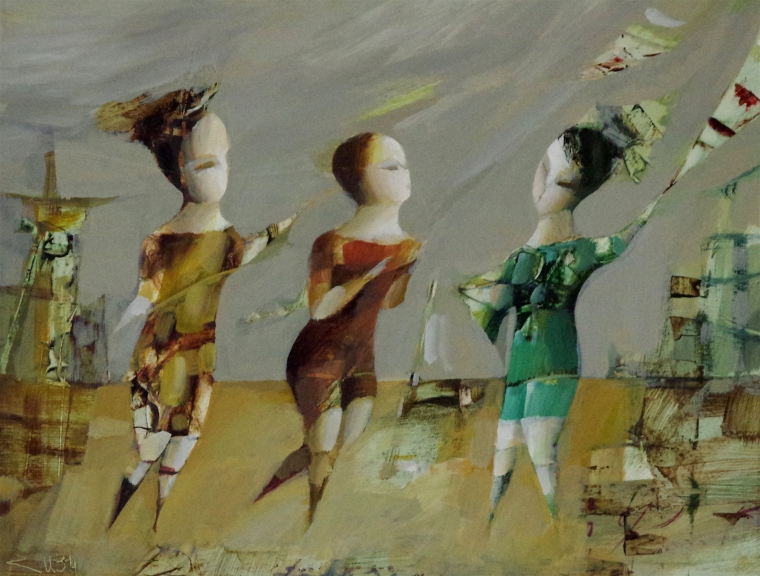The Effect of Figurative Oil Painting on Modern Art and Society
The Effect of Figurative Oil Painting on Modern Art and Society
Blog Article
Mastering the Art of Metaphorical Oil Paint: Vital Tips and Techniques for Aspiring Artists
Figurative oil paint stands for an intricate intersection of technique and analysis, demanding a thorough comprehension of human anatomy, structure, and color theory. An expedition of shade consistency and appearance methods can dramatically enhance the aesthetic effect of their work.

Recognizing Human Anatomy
Understanding human anatomy is essential for any kind of musician striving to grasp figurative oil paint. A detailed grasp of the human type makes it possible for artists to create natural depictions that reverberate with viewers. Knowledge of anatomical structures, such as bones, muscle mass, and joints, offers important understanding right into how the body actions and positions.
Artists should acquaint themselves with the percentages of the human figure, including the connection between different body parts and exactly how these percentages differ across ages and genders. This recognition enables for exact scaling and point of view in their job. In addition, recognizing the underlying musculature enhances the capacity to depict activity and stress in a number, causing a more compelling and dynamic structure.
Studying anatomy additionally helps in identifying refined subtleties in stance and expression, which are crucial for conveying feeling and story within a paint. Resources such as physiological books, life illustration sessions, and on the internet tutorials can be very useful tools for artists looking for to grow their physiological expertise. Ultimately, mastering human anatomy not only boosts technical skill yet likewise enriches a musician's innovative vision, allowing them to bring their metaphorical oil paints to life with credibility and depth.
Importance of Structure

Trick concepts of make-up include equilibrium, unity, and centerpieces. Attaining balance ensures that no single element overwhelms the others, while unity produces a feeling of harmony throughout the piece. Centerpieces accentuate significant elements of the artwork, allowing customers to engage with the story or style much more deeply.
Furthermore, using leading lines and the rule of thirds can substantially improve composition. Leading lines naturally lead the visitor's look through the painting, while the policy of thirds supplies a structure for putting vital aspects in an aesthetically enticing way. By understanding composition, aspiring artists can raise their figurative oil paints, changing them right into compelling visual stories that reverberate with their audience.
Learning Shade Theory
Shade theory functions as a basic facet of figurative oil painting that complements the concepts of structure. Recognizing the shade wheel, which includes key, second, and tertiary shades, is necessary for producing harmonious schemes and reliable aesthetic stories.
Trick principles such as worth, saturation, and tone play an important role in determining the state of mind and impact of a painting. Musicians should discover cool and cozy shades to stimulate specific feelings; warm shades usually communicate power and interest, while awesome colors can impart peace and serenity.
The partnership between complementary shades-- those contrary each various other link on the shade wheel-- can develop striking contrasts and dynamic compositions. When juxtaposed, these colors improve each other's vibrancy, drawing the visitor's eye and adding depth to the art work.
In addition, understanding comparable shades allows artists to attain a feeling of unity and coherence. By choosing colors that are nearby on the wheel, one can preserve a well balanced atmosphere throughout the piece.
Inevitably, mastering color concept equips aspiring musicians with the devices necessary to control shade deliberately, improving their capacity to share feeling and narrative through metaphorical oil painting. figurative oil painting.
Techniques for Texture
A selection of techniques can properly produce texture in figurative oil painting, including deepness and dimension to the art work. One fundamental technique is using impasto, where thick layers of paint are put on the canvas, enabling a three-dimensional high quality. This technique improves light communication, producing dynamic aesthetic rate of interest.
One more technique is scumbling, which involves using a thin layer of lighter paint over a dried darker layer. This method allows the underlying shade to reveal via, causing a soft, textured effect that can evoke a sense of atmosphere or age. Dry cleaning is additionally crucial; using a completely dry brush with minimal paint, musicians can produce great lines and fragile textures, ideal for capturing the nuances of skin or material.
In addition, combination blades can be used to scrape or use paint, creating special patterns and structures. Explore different devices and materials, such as sponges or rags, can further enrich the textural top quality of a paint. Eventually, mastering these techniques calls for practice and trial and error, allowing musicians to find the varied tactile qualities that can raise their figurative works.
Creating Your Special Design
A musician's special design is commonly the culmination of personal experiences, affects, and techniques refined over time. Creating this originality in metaphorical oil paint calls for a conscious effort to discover both your psyche and the more comprehensive artistic landscape. Begin by assessing the themes and topics that reverberate with you psychologically; your enthusiasm will certainly instill authenticity right into your work.
Research different designs and movements, however instead of mimicing, extract elements that talk to you - figurative oil painting. Explore different techniques, shade schemes, and structures, allowing on your own the liberty to play without the pressure of excellence. Maintain a sketchbook or journal to document your ideas, ideas, and artistic progression; this will certainly work as an important resource for recognizing repeating concepts and choices
Seek constructive feedback from peers or coaches, as they can supply understandings that illuminate facets of your work you may ignore. Go to workshops and exhibitions, immersing on your read the full info here own in the visit this page art community to further refine your viewpoint. Lastly, endure on your own; the trip of developing an unique design is continuous, advancing with every canvas and each brushstroke you experience. Embrace the process as much as the result, and your unique voice will arise.

Final Thought
Understanding metaphorical oil painting necessitates a comprehensive grasp of human makeup, composition, and color concept. The assimilation of these elements not only enhances technological abilities but likewise improves the psychological vibration of the artwork. Additionally, the exploration of structure strategies adds to a richer visual experience. Ultimately, the cultivation of a special design via continual practice and reflection is important for creative innovation. Welcoming these fundamental concepts will significantly benefit aspiring artists on their creative journey.
Figurative oil painting represents a complex intersection of strategy and analysis, requiring a detailed comprehension of human makeup, make-up, and shade concept. An exploration of color harmony and texture techniques can significantly enhance the aesthetic effect of their job. By grasping structure, striving artists can elevate their figurative oil paintings, changing them right into compelling visual tales that reverberate with their target market.
Experiment with various methods, shade combinations, and structures, enabling yourself the liberty to play without the stress of perfection.Mastering figurative oil paint demands a detailed grasp of human makeup, composition, and color theory.
Report this page